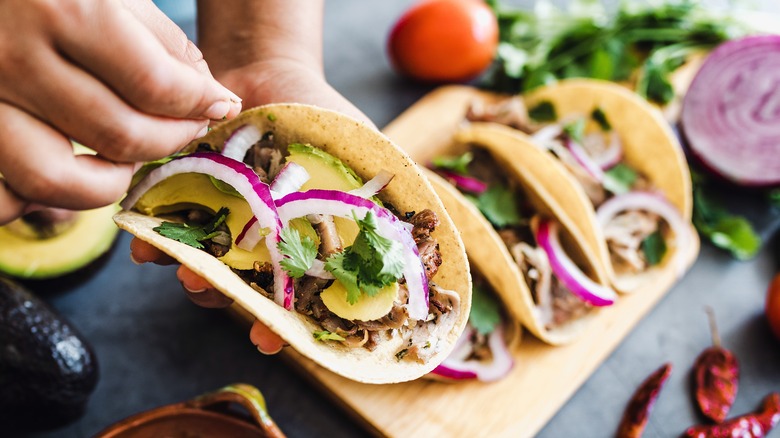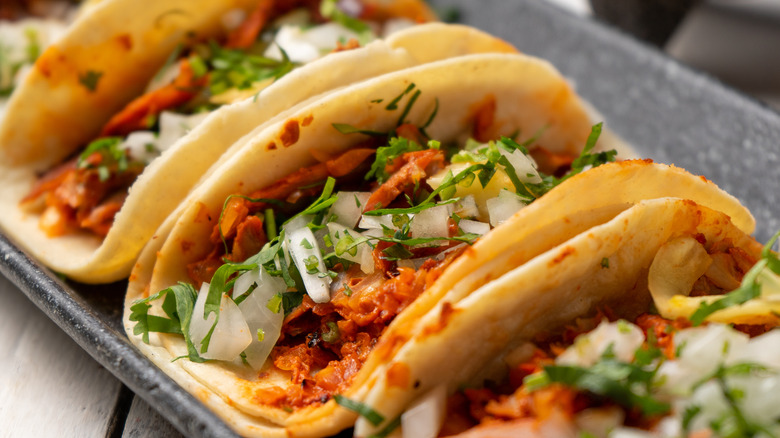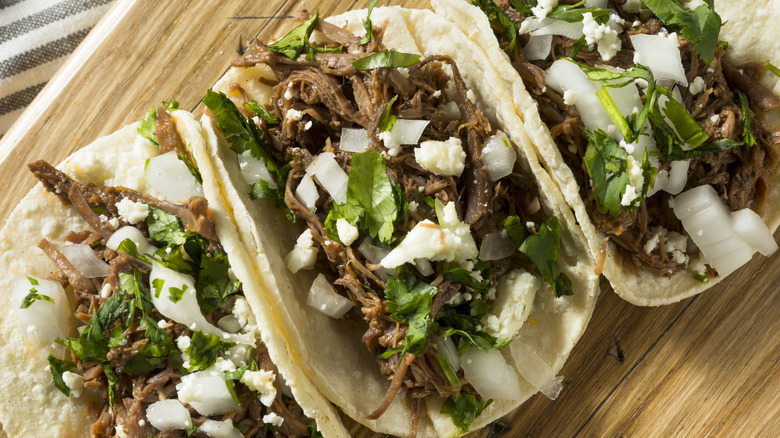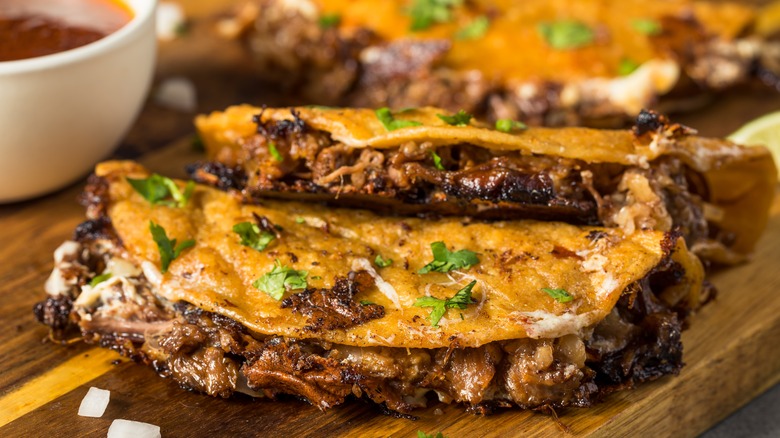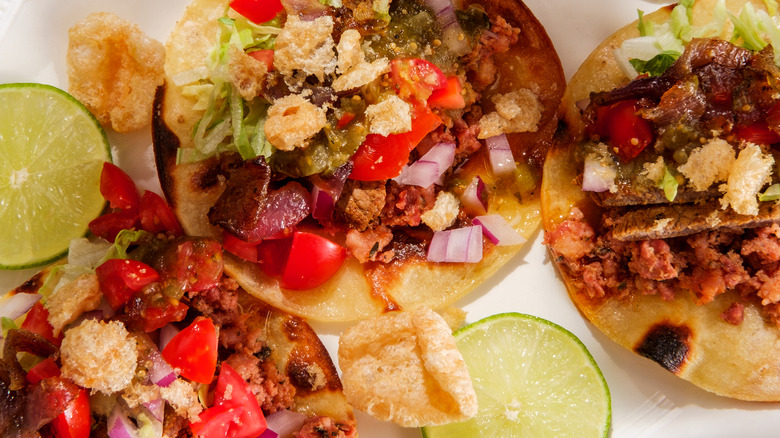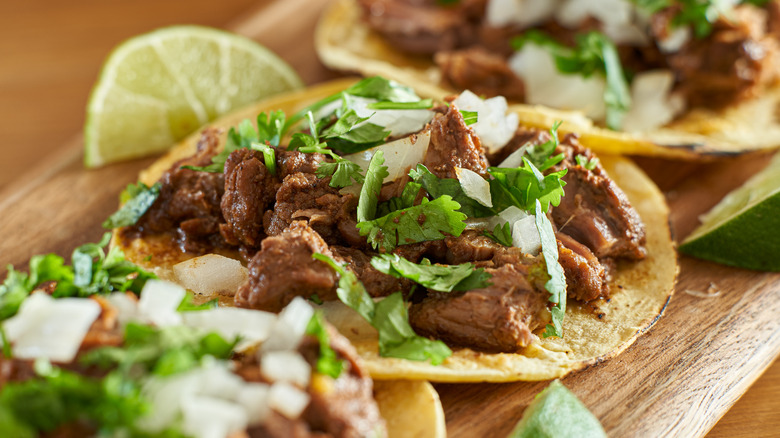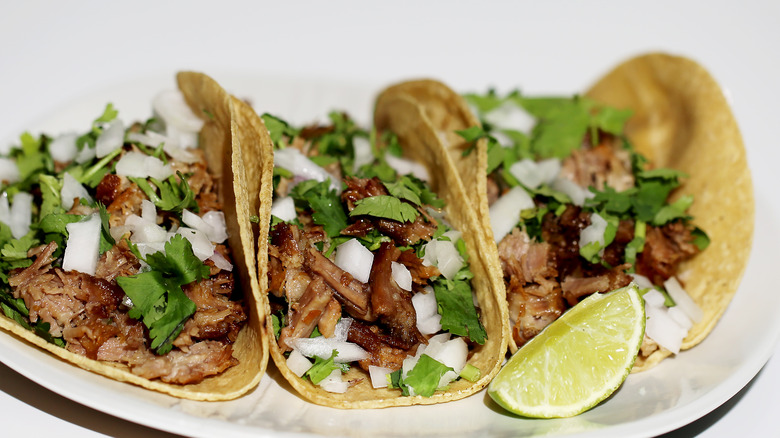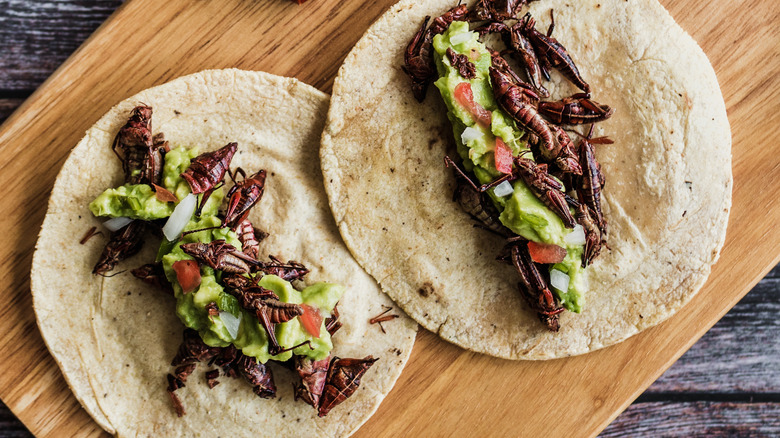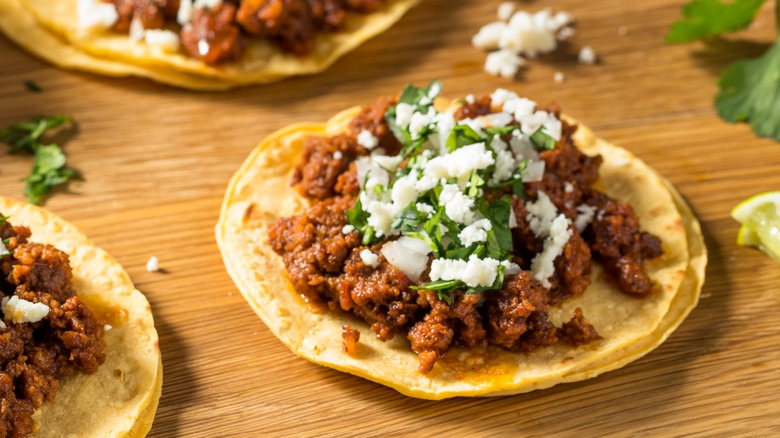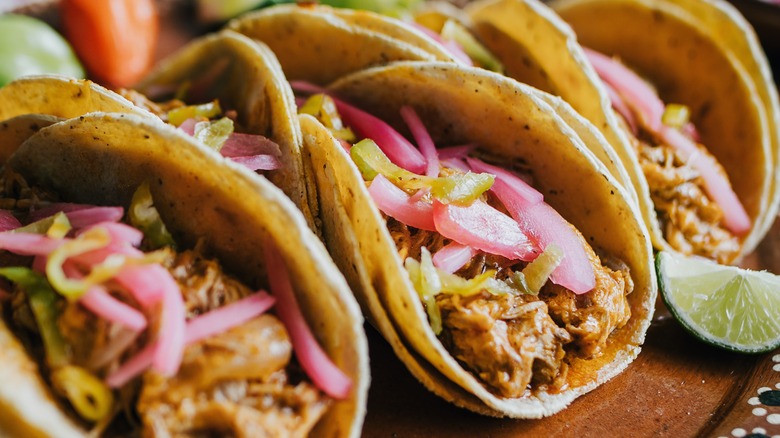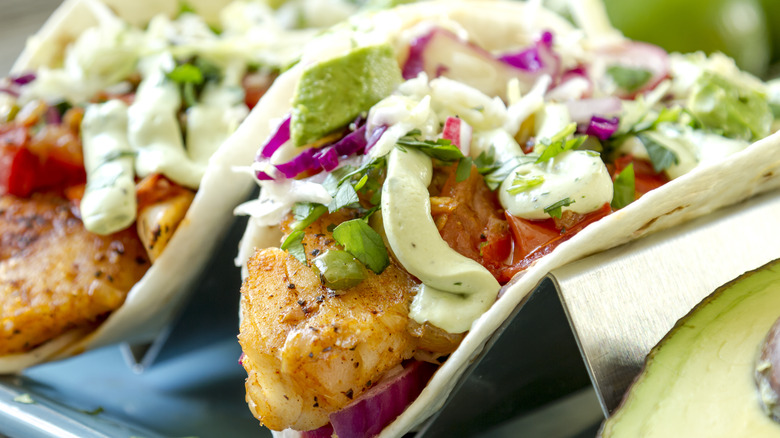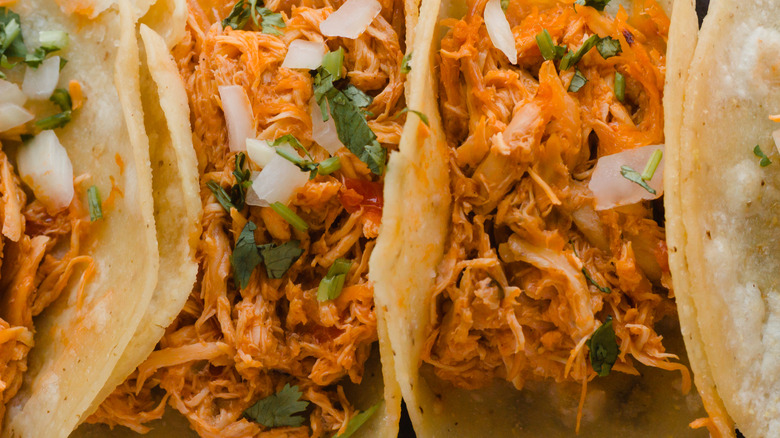11 Types Of Taco Meat To Try At Your Next Taco Tuesday
Taco Tuesday is a glorious tradition that involves exactly what its name implies: eating tacos on Tuesday. While plenty of Taco Tuesday observances take place at home today, Thrillist reports that this American tradition dates back to at least the 1930s, when restaurants began offering promotions for discounted tacos on Tuesday. Yes, like so many beloved American traditions, this one is commercial in origin. Oh, and there's plenty more fascinating truth about the Taco Tuesday term that you might want to check out before your next fiesta, too.
You're welcome to chow down on mildly seasoned ground beef with shredded cheese, torn lettuce, and diced tomato like many Americans who claim to love tacos, but if you prefer some real flavor and are interested in introducing a little Mexican authenticity to Taco Tuesday, there's an entire world of better meats and preparations to employ for game-changing tacos. Whether you're headed to the taqueria or whipping up dinner at home, here are 11 can't-lose taco meats to try at your next Taco Tuesday (and there's a bonus vegetarian alternative in there, too).
Al pastor
As easily as you can put most ingredients on top of a pizza, you can stuff just about anything into a taco. While pineapple on pizza may be a seriously divisive issue, though, it's far more accepted as a critical ingredient of tacos al pastor. Traditionally, tacos al pastor were made with lamb but, as MexConnect reports, they're more commonly made with thinly sliced pork today. On street carts and in taco shops in Mexico, you'll find this marinated meat served on a vertical spit, called a trompo, and that's because of its origin within the Lebanese community that emigrated to Mexico in the 1930s (via Historical Mexico), bringing shawarma with them. Over generations, the lamb was swapped for pork and pita for tortillas, and tacos al pastor were born.
But back to the pineapple. Atop any trompo of al pastor meat, you'll find pineapple slowly dripping its sticky juices into the rotating meat below. It certainly adds a slightly sweet and tangy profile to the meat, but it's also a natural tenderizer, so its initial inclusion was more likely a matter of practicality than flavor inspiration. Today, you'll typically find a few chunks of pineapple in your prepared tacos, too, so it's fair to say the added taste of pineapple is now an integral flavor factor of these tacos. Give them a try with this tacos al pastor recipe.
Barbacoa
When you're ready to ditch the ground beef of typical US Taco Tuesdays but don't want to leave beef behind completely, turn to beef barbacoa tacos. You can use a number of beef cuts for this preparation, as long as you season it well and slow-cook it to tender shreds. My Latina Table reports that barbacoa is often prepared for just about any family gathering in Mexico, from sports events to birthdays and weddings, and recipes can vary dramatically from place to place, so you won't be constrained by a rigid recipe if you decide to go a more authentic route by tackling this classic for your next Taco Tuesday. There is one key ingredient that must never be omitted when preparing barbacoa, though, and that's dried chili. It takes a few steps to prep dried chilis for use in beef barbacoa, but don't let that stop you: It's not difficult.
According to The Recipe Critic, you can prepare beef barbacoa in shorter periods of time, but the longer you can let it cook at lower temperatures, the more tender and delicious your final product will be, and that's why she always uses a slow cooker for her barbacoa. If you're a fast-foodie, you can try this Chipotle copycat recipe for barbacoa, but keep in mind that it does not include true dried chili so you'll be missing some serious authenticity.
Birria
Unless you never use social media and haven't gone out for tacos in a couple of years, you're already very familiar with birria tacos. But you're probably only familiar with one of many versions of birria taco, and that's the fried beef and cheese birria, quesabirria, served alongside a dipping consommé. But The New York Times reports there's really no set recipe for birria across Mexico, or even within a single region, and that means there's probably a lot you didn't know about birria tacos, even if you've had dozens.
According to Vallarta Eats, birria originated in the Mexican state of Jalisco, best known as the place where tequila is made. It was originally made with goat meat, but can also be made from veal, lamb, pork, or the beef that took social media by storm. But it's that original, gamey goat meat that caused so many strong spices to be introduced to birria and, while recipes may vary, a good birria will always come with that signature spiced quality that makes it such a hearty and satisfying snack or meal. And hey, since it hails from the land of tequila, you have an authentic excuse to pair your favorite spirit with a birria recipe on your next Taco Tuesday. Salud!
Campechanos
You're here because you want to mix up your next Taco Tuesday with some more exciting meats than ground beef, but if you're having a hard time deciding exactly which meat to approach next, why not forget about deciding and use them all? Tacos campechanos are one of the few tacos that come with not just one meat, or even two, but a collection of mixed meats. Eat Your World reports that a typical taco campechano in Mexico City would include grilled beef, chicharrón, and longaniza sausage, but that's hardly the only acceptable combination. As La Piña en La Cocina describes, this is a taco of leftovers for Mexican families, so that mixed meat is often whatever needs to be used up before it gets wasted.
Mexican-American celebrity chef Rick Martínez recommends cooking a giant pot of campechanos for a dinner party, making it the perfect choice if you're hosting a handful of guests for your next Taco Tuesday. In this version, you'll throw all of your meats in a giant pot, like traditional Mexican taqueros, and let it simmer while you entertain your friends and family. When it's finished, you can simply pull out all the meat and cut it up to use as tortilla filling, or you can go totally traditional and mix that meat with some of the cooking juices, dipping your tortilla in the remaining broth before briefly throwing them onto a super hot griddle for a full-on taco campechano.
Carne asada
Like several of the meats on this list, that which makes a carne asada taco is less about the specificity of the meat, and more about the way it's cooked. In this case, it's almost completely about how it cooks, since carne asada translates simply to grilled meat. Still, as Backyard Taco reports, carne asada is commonly understood to be a style of cooking beef, often skirt steak or flank steak.
According to Backyard Taco, there are generally three main tenets required for a true carne asada: the meat must be thinly sliced, cooked quickly at very high heat, and flavored with either a marinade or rub. Because there's no specific collection of herbs and spices required in a carne asada marinade or rub, the finished flavor potential is nearly limitless. You'll have plenty of opportunity to put your personal spin on these if you try them on your next Taco Tuesday with this carne asada recipe as a base.
If you'll be entertaining, feel free to impress your guests with this fun nugget of culinary history: According to The New York Times, cows were once considerably thinner and their meat, therefore, much tougher, so thin slices of meat cooked and crisped quickly at high heat helped prevent the beef from becoming any tougher while cooking.
Carnitas
If you've ordered tacos even a handful of times, you've certainly seen carnitas offered on the menu and have probably sampled them at least once. At their core, tacos de carnitas are filled with gently seasoned and slowly braised pork, resembling something like a pulled pork sandwich served on a tortilla instead of a bread roll. In other words, they look familiar to Americans, so they're a popular taco option in the US. Likewise, they're commonplace in Mexico. El Pollo Norteño says you'll find tacos de carnitas at most festive occasions, and at every Sunday market in Mexico.
Still, if you head to Michoacán, the carnitas capital of Mexico, Discover Baja says you'll find that ordering carnitas is not quite as simple as what you may be used to in the US. There are no fewer than 22 ways to order carnitas here, and it all depends on which parts of the pig you crave. Essentially, every part is up for grabs, from the more common ribs and legs all the way to the brain and uterus. Locals tend to order their carnitas prepared mixto (a mix of whatever the chef has on hand), but beginners may want to stick with a chamorro order (the best part of the leg). At home, feel free to take it easy with a simple crock-pot carnitas recipe that uses readily available pork shoulder.
Chapulines
Stick with us here. You're the one who asked for more meat options for your tacos. Chapulines are grasshoppers, and they're an exciting option for a Taco Tuesday filling you probably haven't tried before. The Institute of Culinary Education reports that grasshoppers have been common fare in Mexico since the 16th century, serving as a solid source of protein before the Spanish brought domesticated animals to the area, and the culture of eating them hasn't waned. Like most meats, they're best enjoyed cooked, when their skin becomes crunchy and there's none of the mush that may have populated your mind when considering eating bugs. They're also seasoned, because toasted or fried grasshopper has inherently little flavor, proving that there's nothing to dislike here. If you're struggling, it's all about mind over matter.
More recently, grasshoppers have made their way to certain US circles. As Texas Monthly reports, chapulines have popped up on US menus ranging from taco shops to serious fine dining, and gold-covered grasshoppers have appeared on at least one cooking competition show. Still, you're most likely to find these critters in the US bagged and seasoned as a snack food for those looking for healthier and more sustainable protein bites. For your next Taco Tuesday, feel free to stuff a tortilla with a handful of toasted chapulines to really dive into the culture, but it's also fine to just sprinkle a couple on top of your favorite other taco meat if this is your first time.
Chorizo
Back to a meat you're probably more familiar with, and likely have already enjoyed. Chorizo is a spiced sausage, and BBC Good Food tells us its signature smoky flavor comes from the smoked Spanish paprika that also brings the heat to this meat. If you've had slices of chorizo on a charcuterie board and are wondering how that texture would hold up inside a tortilla, it's time to educate yourself on the difference between Spanish chorizo and Mexican chorizo. The sausage is popular in both countries, but typically served in very different ways. In Mexico, chorizo is not cured like a salami, but prepared to be used as an ingredient more than a finished product. In this format, it's much easier to understand chorizo accenting, or entirely filling, a delicious taco.
You can buy Mexican chorizo readymade for your Taco Tuesday, but if you can't find it or just prefer to make everything from scratch (yay for you!), you can do so without worry. This Mexican chorizo recipe is easy to assemble and, if you generally keep a well-stocked spice cabinet, you may even have all the ingredients on hand already. To prepare a traditional Mexican chorizo taco like the ones you'd find at street carts, simply stuff a corn tortilla with your Mexican chorizo and top with chopped onion and cilantro. Squeeze a fresh lime wedge over your creation to seal the deal.
Cochinita pibil
We know we already said this about carnitas, but cochinita pibil is like pulled pork to Americans. Even more than carnitas. As AFAR reports, this treasure of the Yucatán is also prepared by slow-cooking pork and shredding the finished product, but it's marinated in citrus juice with a seasoning mix that includes paste made from red achiote seeds. This deep-colored marinade is what really gives the finished dish an even stronger resemblance to pulled pork in barbecue sauce. The primary reason you haven't seen this preparation on as many US taco menus as carnitas, though, probably rests in its more complicated preparation.
As we've seen before, this dish is named for how it's prepared. Explorando Mexico notes that cochinita pibil is traditionally cooked in an underground Maya oven called a pibil, and there aren't many US restaurants, or even homes, that have one of these subterranean caves on their properties. But don't fret — you can still prepare cochinita pibil in your kitchen, no matter how small or American it may be. Hola Jalapeño says you can cook a comparable cochinita pibil in your oven and recommends likely places to find less common ingredients like achiote and banana leaves.
Pescado
If you're not at all familiar with Spanish, pescado is the word for fish (specifically fish that has been already caught, not one still alive and swimming), so this is nothing more than the popular fish taco you already know and possibly love. And if you've also heard of Baja fish tacos and are wondering what the difference is, there isn't one. As NPR reports, modern fish tacos were first created in the 1950s in either the town of Ensenada or San Felipe, both of which are found in the eponymous Mexican state of Baja California.
How you batter your fish and dress your taco is open to personal preference and interpretation, but Sunset reports that there are a few basic tenets of any real taco de pescado. Namely, preparing a proper fish taco involves deep frying a lightly battered white fish and topping it with a cabbage slaw, a mayo or cream sauce, some form of salsa, and a squirt of fresh lime juice. If you'll be preparing these for your next Taco Tuesday, we'll give you a head start with this recipe for an easy cabbage slaw perfect for fish tacos.
Tinga
Tinga tacos are almost always prepared with shredded chicken, but it's the sauce that truly makes a tinga a tinga. As The Home Chef Institute describes, tinga can be prepared with any shredded meat, as long as the accompanying tomato-based sauce is used to cook it. Digging further into the sauce ingredient list, you may think you're preparing an Italian dish as you add garlic and onion to your base, but the final ingredient is what truly sets this sauce apart as Mexican: chipotle peppers. These peppers give tinga tacos the kick that balances the sweeter tomato flavor of their signature sauce, and are an essential inclusion.
Of course, as with most tacos and most dishes in general, following an exact recipe is only recommended for beginners, so feel free to customize your chicken tinga tacos however your taste buds see fit. This shredded chicken tinga recipe calls for adding Mexican oregano to your sauce, for example, and you may also want to include cilantro, lime, and even Mexican crema if you need to counter some of the heat of the peppers a bit. And if you've made it all the way to the end of this list in hopes of finding a vegetarian option, here it is: use jackfruit instead of chicken in your tinga sauce for a vegetarian taco that holds up against, and maybe even surpasses, any meaty alternative.
